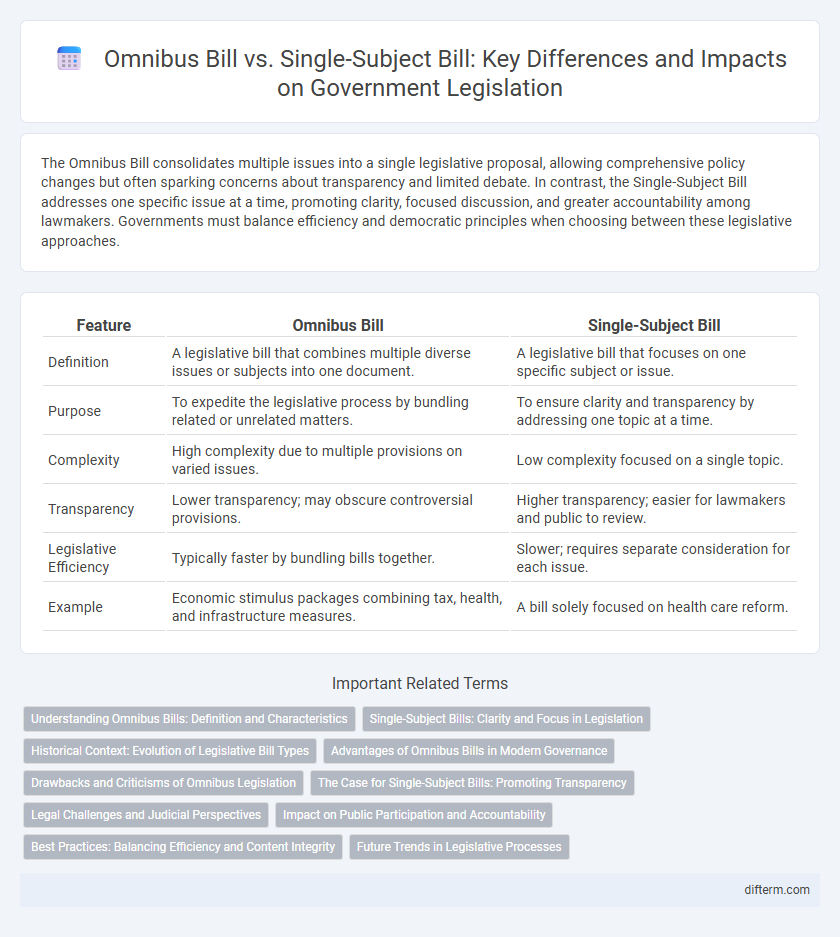The Omnibus Bill consolidates multiple issues into a single legislative proposal, allowing comprehensive policy changes but often sparking concerns about transparency and limited debate. In contrast, the Single-Subject Bill addresses one specific issue at a time, promoting clarity, focused discussion, and greater accountability among lawmakers. Governments must balance efficiency and democratic principles when choosing between these legislative approaches.
Table of Comparison
| Feature | Omnibus Bill | Single-Subject Bill |
|---|---|---|
| Definition | A legislative bill that combines multiple diverse issues or subjects into one document. | A legislative bill that focuses on one specific subject or issue. |
| Purpose | To expedite the legislative process by bundling related or unrelated matters. | To ensure clarity and transparency by addressing one topic at a time. |
| Complexity | High complexity due to multiple provisions on varied issues. | Low complexity focused on a single topic. |
| Transparency | Lower transparency; may obscure controversial provisions. | Higher transparency; easier for lawmakers and public to review. |
| Legislative Efficiency | Typically faster by bundling bills together. | Slower; requires separate consideration for each issue. |
| Example | Economic stimulus packages combining tax, health, and infrastructure measures. | A bill solely focused on health care reform. |
Understanding Omnibus Bills: Definition and Characteristics
Omnibus bills consolidate multiple diverse and often unrelated legislative issues into a single proposal, streamlining the lawmaking process but raising concerns about reduced transparency and limited debate. These bills enable governments to advance extensive regulatory or budgetary changes efficiently, often including provisions that might not pass independently. Understanding the characteristics of omnibus bills is essential for evaluating their impact on legislative transparency, democratic accountability, and policy coherence.
Single-Subject Bills: Clarity and Focus in Legislation
Single-subject bills enhance legislative clarity by addressing one specific issue per proposal, reducing confusion and improving the precision of legal language. This focused approach facilitates more thorough debate and review, ensuring that lawmakers and the public can clearly understand the bill's intent and potential impact. By limiting complexity, single-subject bills help prevent the passage of unrelated or controversial provisions hidden within larger legislative packages.
Historical Context: Evolution of Legislative Bill Types
The evolution of legislative bill types reflects significant shifts in parliamentary practices, with single-subject bills dominating early legislative history due to their focus and transparency. Omnibus bills emerged in the 20th century as governments sought efficiency by combining multiple related provisions into a single legislative package, often streamlining the passage of comprehensive reforms. This transition highlights the balance between legislative efficiency and the need for detailed scrutiny in democratic governance.
Advantages of Omnibus Bills in Modern Governance
Omnibus bills streamline the legislative process by consolidating multiple related measures into a single proposal, reducing the time and resources required for debate and approval in modern governance. This approach enhances policy coherence by allowing lawmakers to address complex issues comprehensively rather than in fragmented segments. Omnibus bills also facilitate greater flexibility in budget allocation and regulatory reforms, supporting efficient and responsive government action.
Drawbacks and Criticisms of Omnibus Legislation
Omnibus bills face criticism for limiting transparency and reducing legislative scrutiny, as they bundle multiple diverse issues into one vote, making it difficult for lawmakers and the public to fully evaluate each component. This legislative approach increases the risk of hidden or controversial provisions being passed without proper debate, undermining democratic accountability. Critics argue that omnibus legislation can concentrate excessive power in the executive branch and weaken checks and balances designed to ensure thorough policy analysis.
The Case for Single-Subject Bills: Promoting Transparency
Single-subject bills enhance legislative transparency by ensuring each bill addresses only one specific issue, which simplifies public understanding and scrutiny. This focused approach prevents the inclusion of unrelated provisions that can obscure the bill's purpose and complicate voter awareness. By promoting clarity and accountability, single-subject bills reduce the risk of hidden or controversial measures being passed without proper evaluation.
Legal Challenges and Judicial Perspectives
Omnibus bills often face legal challenges due to their inclusion of multiple, unrelated subjects, raising concerns about violating single-subject rules designed to prevent legislative confusion and protect transparency. Judicial perspectives frequently emphasize the importance of upholding constitutional provisions to ensure bills remain focused and accessible, allowing courts to invalidate omnibus legislation that oversteps these boundaries. Single-subject bills, by contrast, reduce judicial scrutiny by adhering to clear legislative limits, promoting more straightforward legal interpretation and reducing the risk of constitutional disputes.
Impact on Public Participation and Accountability
Omnibus bills often consolidate multiple policy areas into one comprehensive package, which can limit public participation by reducing opportunities for detailed scrutiny and debate on individual issues. Single-subject bills enhance transparency and accountability by allowing stakeholders and citizens to focus on specific legislation, fostering more informed public engagement. This clarity in legislative focus promotes greater governmental accountability as lawmakers are held directly responsible for discrete policy decisions.
Best Practices: Balancing Efficiency and Content Integrity
Omnibus bills streamline legislative processes by consolidating multiple issues into a single measure, enhancing efficiency but risking reduced scrutiny and potential content dilution. Single-subject bills promote content integrity by focusing exclusively on one topic, allowing for detailed examination but potentially slowing legislative progress. Balancing these approaches involves implementing rigorous review protocols for omnibus bills and maintaining transparent criteria for bill composition to safeguard thorough policy evaluation without sacrificing legislative productivity.
Future Trends in Legislative Processes
Future legislative processes will increasingly favor omnibus bills to streamline decision-making and address complex, interconnected policy issues within a single framework. However, the push for transparency and accountability is likely to invigorate support for single-subject bills, which ensure focused debate and reduce legislative bundling that can obscure constituent interests. Emerging digital tools and data analytics will enhance lawmakers' ability to assess omnibus bill impacts while preserving the clarity inherent in single-subject legislation.
Omnibus Bill vs Single-Subject Bill Infographic

 difterm.com
difterm.com